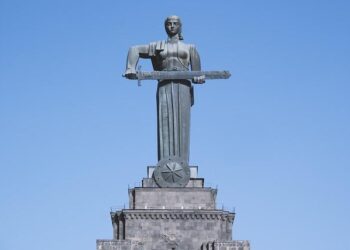The United States has stepped forward with a proposal to oversee the management of a disputed corridor between Armenia and Azerbaijan, aiming to ease ongoing tensions in the volatile South Caucasus region. This initiative, reported by Middle East Eye, comes amid renewed diplomatic efforts to stabilize a strategic passage whose control has long been a flashpoint in the complex Armenia-Azerbaijan conflict. Washington’s offer marks a significant development in international involvement, as regional and global powers seek to prevent further escalation and foster dialogue between the two neighbors.
US Proposes Monitoring Role in Armenia-Azerbaijan Corridor to Enhance Regional Stability
The United States has put forward a proposal to assume a monitoring role along the strategically sensitive corridor connecting Armenia and Azerbaijan. This initiative comes amid ongoing tensions and aims to ensure safe and uninterrupted transit while reducing the risk of military escalations in a region long marked by conflict. Washington’s involvement is envisioned as a part of broader diplomatic efforts to stabilize the South Caucasus, fostering cooperation between the two countries and supporting ongoing peace negotiations.
Key aspects of the proposed monitoring mission include:
- Deployment of neutral observers to oversee traffic and security
- Implementation of real-time reporting mechanisms to prevent incidents
- Facilitation of communication channels between Armenian and Azerbaijani authorities
- Support for reconstruction and maintenance efforts along the corridor
| Role | Responsibility | Expected Outcome |
|---|---|---|
| Monitoring Team | Observe and report on corridor activity | Early detection of threats |
| Diplomatic Liaison | Coordinate between conflicting parties | Improved communication |
| Technical Support | Maintenance of infrastructure | Uninterrupted transit |
Implications of American Oversight for Post-Conflict Cooperation and Security
The involvement of the United States as a supervisory body in the contested corridor between Armenia and Azerbaijan introduces a critical dynamic to regional stability and post-conflict recovery. By positioning itself as an impartial overseer, the US aims to facilitate transparency in border management, deter illicit activities, and reduce the risk of sudden escalations. This role not only reassures both parties about adherence to agreements but also signals broader international commitment, potentially attracting further diplomatic and economic investments to the fragile region.
However, American oversight also carries nuanced implications for local power balances. While fostering cooperation, it may also provoke skepticism from regional actors wary of external influence. The success of such involvement depends largely on effective coordination with existing peacekeeping missions and regional organizations. Below is a snapshot of the possible consequences and opportunities tied to this US-led initiative:
| Implications | Potential Outcomes |
|---|---|
| Security Enhancement | Reduced border incidents, improved communication channels |
| Political Trust-Building | Strengthened bilateral relations, groundwork for future agreements |
| Geopolitical Tensions | Possible friction with Russia and regional powers |
| Economic Development | Increased cross-border trade, reconstruction investments |
- Enhanced monitoring mechanisms could stem from American oversight, providing real-time intelligence to minimize risks.
- Long-term cooperation frameworks may evolve, encouraging multilateral engagement beyond US involvement.
- Challenges include balancing external intervention without undermining sovereignty or inflaming nationalist sentiments on either side.
Recommendations for Ensuring Transparency and Multilateral Engagement in Corridor Management
To foster genuine confidence among stakeholders, it is critical that any corridor management mechanism integrates transparent monitoring systems. This can be achieved through the deployment of independent observers equipped with real-time data sharing capabilities, ensuring that all parties have equal access to corridor activity information. Additionally, the establishment of a publicly accessible digital platform detailing transit schedules, security updates, and incident reports will reduce misinformation and speculation, paving the way for trust-building.
Multilateral engagement must extend beyond mere oversight, embracing a collaborative governance framework that includes representatives from Armenia, Azerbaijan, and neutral international actors. Facilitating regular joint coordination meetings and conflict resolution forums can promote dialogue and prevent escalations. The following table outlines key components recommended for such a governance structure:
| Component | Purpose | Lead Role |
|---|---|---|
| Joint Security Coordination | Ensure border safety and quick response to incidents | International Monitors |
| Data Transparency Portal | Public access to corridor operations and updates | Neutral Tech Agency |
| Bilateral & Multilateral Meetings | Regular dialogue and issue resolution | Armenian & Azerbaijani Officials + Observers |
- Independent auditing of corridor logistics and security protocols.
- Inclusivity in decision-making, giving voice to local communities.
- Predictable transit policies that support uninterrupted trade and mobility.
- Deploy independent observers with real-time data sharing capabilities.
- Create a publicly accessible digital platform displaying transit schedules, security updates, and incident reports to reduce misinformation.
- Engage representatives from Armenia, Azerbaijan, and neutral international actors.
- Facilitate regular joint coordination meetings and conflict resolution forums.
- Independent auditing of corridor logistics and security protocols.
- Inclusivity in decision-making, ensuring local community participation.
- Predictable transit policies to sustain uninterrupted trade and mobility.
Certainly! Here’s a concise summary of the key recommendations for an effective corridor management mechanism based on your content:
Key Recommendations for Corridor Management Mechanism
1. Transparent Monitoring Systems:
2. Collaborative Governance Framework:
3. Governance Structure Components:
| Component | Purpose | Lead Role |
|—————————–|————————————————|——————————————–|
| Joint Security Coordination | Ensure border safety and quick response to incidents | International Monitors |
| Data Transparency Portal | Public access to corridor operations and updates | Neutral Tech Agency |
| Bilateral & Multilateral Meetings | Regular dialogue and issue resolution | Armenian & Azerbaijani Officials + Observers |
4. Additional Principles:
If you need help expanding on any of these points or developing a more detailed plan, feel free to ask!
To Conclude
The United States’ offer to oversee the disputed Armenia-Azerbaijan corridor marks a significant development in the ongoing efforts to stabilize the volatile region. As tensions continue to simmer, Washington’s proposed role underscores the international community’s growing involvement in facilitating dialogue and ensuring security. The coming weeks will be critical in determining whether this initiative can pave the way for a lasting resolution or if entrenched challenges will impede progress along this strategically important corridor.
















